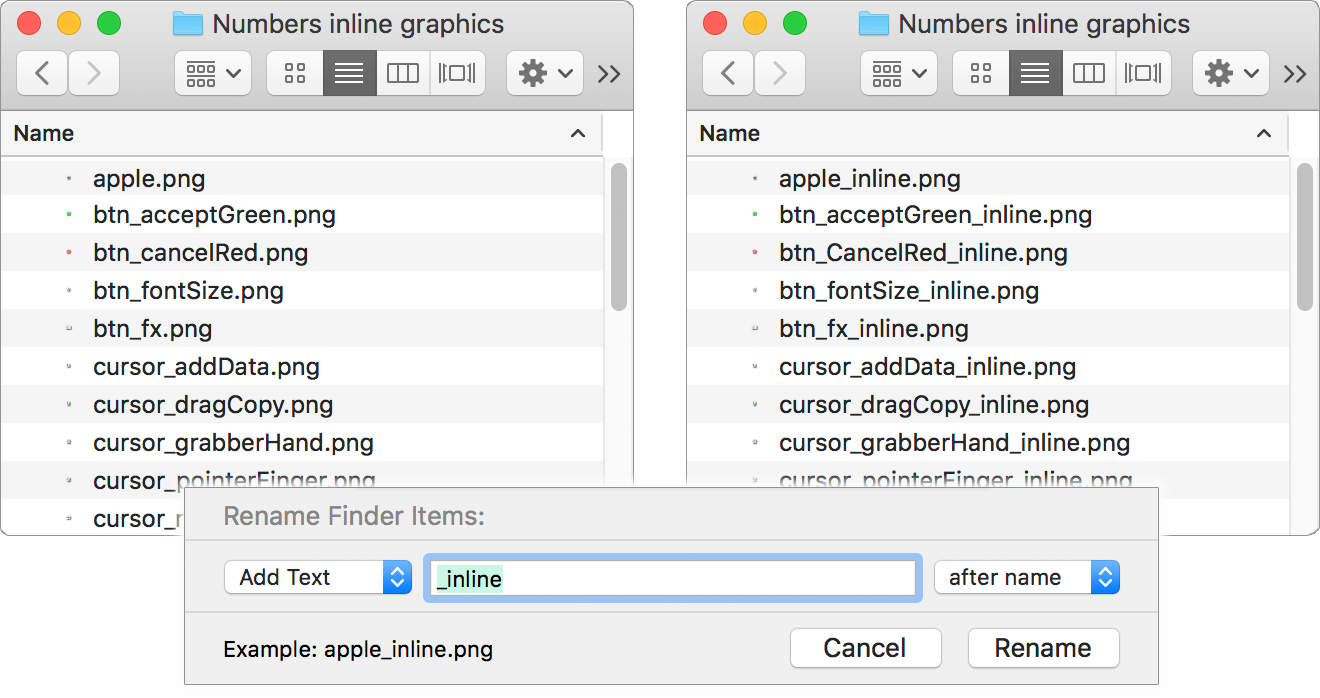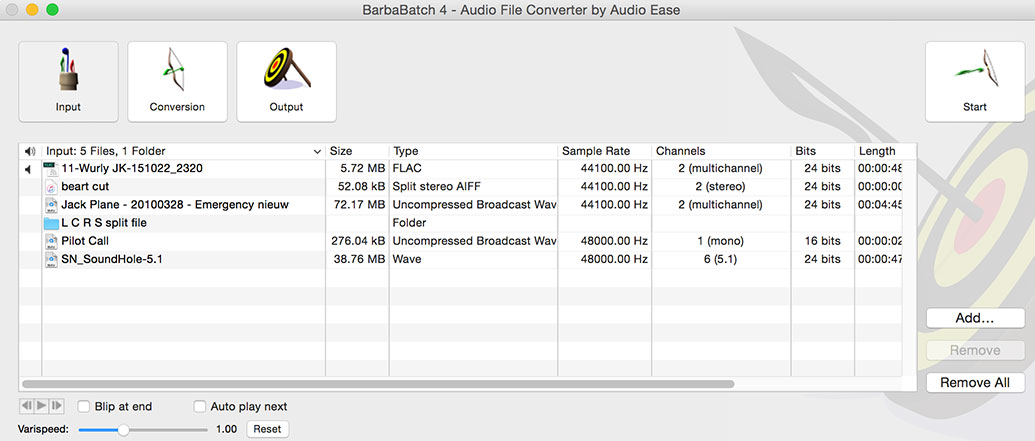Batch File For A Mac
Select the files all, right-click (or Control-Click) and choose Rename XX items. In the Rename Finder Items Window, click Replace Text from the drop-down menu. In the Replace With: box, type the file extension you choose to batch change all selected items to, and in the Find: box type in the original file extension of selected files. Also Read: Best Mac Games 2018. Batch Rename Files on Mac Using Automator. If you are on prior to the Yosemite (Mac OS 10.10) version, you will require using a built-in tool like Automator to first create a workflow to batch rename files. To do this, follow these steps. Free to try roventskij Mac OS X 10.2/10.3 Version 1.5.2 Full Specs. When batch converting raw image files you can set the white balance to none. From the Finder of the Mac, pull down the “Finder” menu and go to “Preferences” and then go to. Batch Mac File For How A To Write Here is a simple script I wrote that reads text from a file. Now is the important part; Go to the Help Pull Down Menu and select 'Script Editor Help' it will open the AppleScript User Guide for your Current OS - Surprise it is updated in Mojave To re-iterate the batch-making process: first, create an empty.
Conditionally perform a command several times.
The operation of the FOR command can be summarised as...
- Take a set of data
- Make a FOR Parameter %%G equal to some part of that data
- Perform a command (optionally using the parameter as part of the command).
- Repeat for each item of data
If you are using the FOR command at the command line rather than in a batch program, use just one percent sign: %G instead of %%G.

FOR Parameters
The first parameter has to be defined using a single character, for example the letter G.
FOR %%G IN ...
In each iteration of a FOR loop, the IN ( ....) clause is evaluated and %%G set to a different value
If this clause results in a single value then %%G is set equal to that value and the command is performed.
If the clause results in a multiple values then extra parameters are implicitly defined to hold each. These are automatically assigned in alphabetical order %%H %%I %%J ...(implicit parameter definition)
If the parameter refers to a file, then enhanced variable reference can be used to extract the filename/path/date/size.
You can of course pick any letter of the alphabet other than %%G.
%%G is a good choice because it does not conflict with any of the pathname format letters (a, d, f, n, p, s, t, x) and provides the longest run of non-conflicting letters for use as implicit parameters.
G > H > I > J > K > L > M
Format letters are case sensitive, so using a capital letter is also a good way to avoid conflicts %%A rather than %%a.
Examples
FOR /F 'tokens=1-5' %%A IN ('This is a short sentence') DO @echo %%A %%B %%D
will result in the output: This is short
Create a set of 26 folders, one for each letter of the alphabet:
FOR %%G IN (a,b,c,d,e,f,g,h,i,j,k,l,m,n,o,p,q,r,s,t,u,v,w,x,y,z) DO (md C:demo%%G)
Using variables within a FOR loop
Variables are expanded at the start of a FOR loop and don’t update until the entire DO section has completed.
The following example counts the files in the current folder, but %count% always returns 1:
@echo off
SET count=1
FOR /f 'tokens=*' %%G IN ('dir /b') DO (
echo %count%:%%G
set /a count+=1 )

To update variables within each iteration of the loop we must either use EnableDelayedExpansion or else use the CALL :subroutine mechanism as shown below:
@echo off
SET count=1
FOR /f 'tokens=*' %%G IN ('dir /b') DO (call :subroutine '%%G')
GOTO :eof
:subroutine
echo %count%:%1
set /a count+=1
GOTO :eof
Nested FOR commands
FOR commands can be nested FOR %%G... DO (for %%U... do ...)
when nesting commands choose a different letter for each part. you can then refer to both parameters in the final DO command.
For an example of exiting the inner loop of two nested FOR loops, see the EXIT page.
If Command Extensions are disabled, the FOR command will only support the basic syntax with no enhanced variables:
FOR %%parameter IN (set) DO command [command-parameters]
Errorlevels
The FOR command does not generally set any errorlevels, leaving that to the command being called.
One exception is using a wildcard, if the wildcard does not match any files, then FOR will return %ERRORLEVEL% = 5
FOR does not, by itself, set or clear the Errorlevel.
FOR is an internal command.
“Those who cannot remember the past are condemned to repeat it” - George Santayana
Related:
FOR - Loop through a set of files in one folder.
FOR /R - Loop through files (recurse subfolders) .
FOR /D - Loop through several folders.
FOR /L - Loop through a range of numbers.
FOR /F - Loop through items in a text file.
FOR /F - Loop through the output of a command.
Parameters/arguments %~ options.
FORFILES - Batch process multiple files.
GOTO - Direct a batch program to jump to a labelled line.
IF - Conditionally perform a command .
Powershell: ForEach-Object - Loop for each object in the pipeline.
Equivalent bash command (Linux): awk or for var in [list]; do - Expand list, and execute commands.
Run Bat File On Mac
Some rights reserved
Keeping your iPhoto organized and managed is not an easy task; especially, when you’ve a huge collection of photos and videos. If you’re a designer or professional photographer, you understand the pain in renaming your files manually. In situations like this, you need a file renaming software that can help you rename multiple files at one go. Luckily, there are some best free file rename software for Mac that can help you to modify the name of the files.
Best Batch File Renaming Software For Mac
1. Renamer
Whether you want to change name for a single file or many at once, Renamer is a software that’s capable of renaming your files in various ways. It is the easiest and quickest way to get an organized and managed library with minimal efforts. Best of all, Renamer is a beautifully designed tool that comes with user-centric interface.
Must Read: Best Free MP3 Tag Editor For Mac In 2019
2. Name Munger
Name Munger is one of the best free file rename tools that swiftly renames one or more files with a simple drag and drop feature. It is a simple yet strong tool that not only allows you to replace text anywhere in a file or folder name but also removes texts from anywhere in a file or folder name. You can modify the file name in upper case, lower case, initial caps, and title caps.
3. NameChanger

NameChanger is an incredible tool that helps you rename files in real time. All you need to do is just download and install the software on your Mac, drag and drop the files and rename the bunch of files with a simple click. It is one of the most reliable software that has been developed by MRR Software and designed for OS X 10.7 and later. Indeed, it is one of the effective batch files rename tools for Mac.

Must Read: Top 10 Must Have Menu Bar Apps for your Mac
4. F2Utility
As the name reflects, it is a useful utility that renames multiple files without asking you to download a wide range of tools. It allows you to cut down the first or last couple of characters, add a prefix/suffix, insert text at a certain position, and trim the file names without any trouble. In fact, F2Utility also lets you re-order a selection of files using hotkeys.
5. Transnomino
Transnomino is a Mac batch utility that finds and replaces the name of the file as per your requirements. You can add file attributes to the filename such as EXIF data, ID3, date-created, etc. Transnomino allows you to format your dates exactly the way you want it to be, just by selecting one of the pre-set formats or by specifying your own. You may also add the numbering at the end of the file name or at the beginning as well.
6. Inviska Rename
It is a cross-platform software and available for Linux, Mac, and Windows. Inviska Rename lets you add, insert, replace and remove the filename text or extension. You can rename files using Exif information from digital photographs, file creation or modification date, music tag information like mp3 ID3v2 tags and FLAC tags. This batch files rename tools for Mac comes with a user-friendly interface.
Batch File For Activate Office 2019
Must Read:8 Best Media Center For Mac
Mac Os Batch File
Overall, these are some of the best free file rename software for Mac you can use to rename a bunch of files together.
Create A Batch File For Mac
Responses

